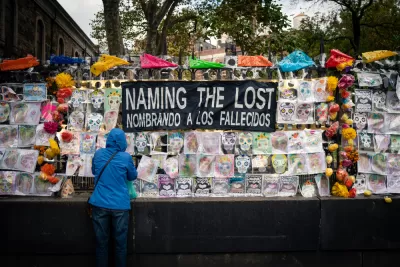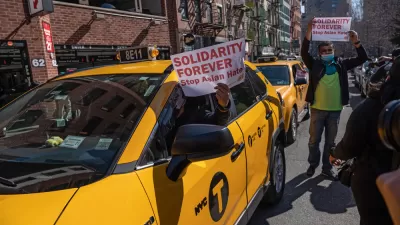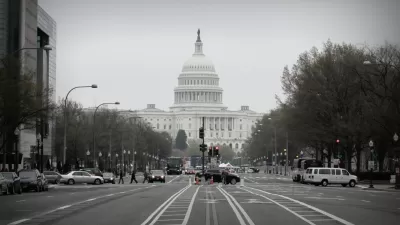The latest in a series of compendia gathering news and analysis about the effects of the COVID-19 on the built and natural environments—now and long into the future.

So much has happened since the last time Planetizen published a pandemic compendium. There's a new president, for one. The vaccine rollout has kicked into a higher gear, but supplies still fall short of the need and are tending to inoculate affluent Americans. And as of this writing, the state of Texas is facing a fatal weather emergency that has people all over the country, including some in Texas, pointing fingers. Texas Governor Greg Abbott teamed up with Fox News to leverage the crisis facing millions of Texans to blame renewable energy and score political points against the Green New Deal (the latter is still mostly a hypothetical)—despite the distinctly and uniquely Texan nature of the state's power grid and plenty of evidence to the contrary. In a scenario that has been repeated time and time again all over the country, affluent Texans have several layers of protections from this crisis that the state's more vulnerable residents lack.
As the vaccine program has gained a foothold around the country, along with the new Biden administration, urbanism media continues to traffic a bewildering mix of speculation and incomplete data about how the coronavirus might alter the future direction of cities and communities, and how planning professionals will be, or already are, changing the focus of their work to respond to the constellation of crises that have risen as a consequence of the pandemic. There's also the large matter of the crises the pre-existing conditions of the built and natural environments that exacerbated the consequences of the pandemic. If you're looking for examples of how one crisis begets another crisis, which then begets another crisis, look no further than The New York Times article, "The Californians Are Coming. So Is Their Crisis."
Since March 2020, Planetizen has been tracking the stories that have attempted to make sense of the world during the pandemic, and how the pandemic might alter the future direction of communities. Many of the themes have repeated, with only slight variations as the coronavirus has revealed its effects for public health, the economy, and society.
- Density Takes Center Stage in the Pandemic, Again (January 2021)
- Nine Months Later: How the Pandemic Is Changing Communities (December 2020)
- Coronavirus and the Future of Cities: A Final Pre-Election Tour of the Issues (November 2020)
- Do We Know Any More About the Future of Cities Than We Did in April 2020? (October 2010)
- The Media Can't Stop Talking About the End of Cities (August 2020)
- The Great Debate: Will the Pandemic Alter the Course of Urbanism? (July 2020)
- Debating the Future of Cities After the Coronavirus, Volume 3 (June 2020)
- Density Debate Rages Alongside the Pandemic (April 2020)
- Debating the Future of Cities, and Urban Density, After the Pandemic (March 2020)
- Coronavirus and Urbanism (Planetizen Tag)
- Coronavirus and Transportation (Planetizen Tag)
- Coronavirus and Density (Planetizen Tag)
Although progress seems to have hung up while the U.S. Senate wrapped up a second impeachment trial for former President Donald Trump, a stimulus bill making its way through Congress promises relief for two of the most pressing crises in the planner's purview, in the form of direct relief for renters and transit agencies.
One unequivocal fact has changed since the last edition of the planning and pandemic compendium: the number of deaths from COVID-19 every day in the United States has decreased significantly. At the beginning of January, the total number of daily deaths temporarily breached 4,000. The seven-day average of U.S. COVID-19 deaths was at 2,821 on February 16, 2021, according to data compiled but the New York Times. Given the weeks of lag between new infections and deaths, the number of deaths should, mercifully, continue to decline.
But perhaps the most telling theme to emerge from the past month-plus of the pandemic experience is the deep inequality in the public health and economic outcomes of the pandemic. The coronavirus spent the past several months tearing through Los Angeles, with its expensive housing market and the hidden epidemic of forced crowding in the scant options at the cheaper end of the housing market. If you're looking for examples of how one crisis begets another crisis, which then begets another crisis, look no further than the Los Angeles Times article, "When coronavirus invaded their tiny apartment, children desperately tried to protect dad."
Urban Exodus
- Increased Remote Work Could Mean Big Changes for Cities (Planning Magazine, Winter 2021)
- What Miami Can Give Techies That San Francisco Can’t (Slate, January 22)
- ‘I’m not bumping into other people and there’s fresh air’: COVID-19 is accelerating the flight of Toronto families to smaller centres (Toronto Star, January 24)
- The 5 Cities Ready to Build With Remote Workers in Mind (Bloomberg CityLab, January 26)
- U-Hauls for the Creative Class (Slate, January 27)
- Toronto has shrunk. Will it reinvent? (Toronto Star, January 29)
- Superstar Cities Are in Trouble (The Atlantic, February 1)
- Will Boston lose its competitive edge in a work-from-home world? (The Boston Globe, February 2)
- What will Houston look like in a post-pandemic world? (Houston Chronicle, February 2)
- As the pandemic persisted, financial pressures became a bigger factor in why Americans decided to move (Pew Research Center, February 4)
- How the Pandemic Left the $25 Billion Hudson Yards Eerily Deserted (The New York Times, February 6)
- Silicon Valley Won't Last Forever, and Texas Knows It (Bloomberg, February 6)
- Mama, I’m Coming Home (February 8, Slate)
- The Pandemic Emptied Europe’s Cities. What Will Bring People Back? (The New York Times, February 11)
- Remote Workers Spur an Affordable Housing Crunch in Montana (Bloomberg CityLab, February 11)
- The Pandemic Is Paving the Way for Better Life Options [paywall] (Bloomberg, February 11)
- The Californians Are Coming. So Is Their Housing Crisis. (The New York Times, February 12)
- Manhattan Couple Ditch Apartment, Buy RV. Was It Worth It? [paywall] (The Wall Street Journal, February 16)
- D.C. restaurant, retail employees face bleak future if remote office work stays prevalent (The Washington Post, February 16)
- If Work Is Going Remote, Why Is Big Tech Still Building? (Wired, February 16)
Urban Regeneration
- Pandemic opportunity? Pumping new life into cities. (The Christian Science Monitor, January 6)
- Why COVID-19 Won’t Kill Cities (Governing, January 28)
- How to Build Back Better, but Better (Slate, February 3)
- Covid offers opportunity to reshape cities, says architect Foster [paywall] (The Financial Times, February 8)
- Urban Exodus? Not So Fast (Demo Memo, February 16)
Housing Crisis Redux
- Yes, the laws of supply and demand still apply in San Francisco housing (San Francisco Chronicle, December 20)
- San Francisco rents are plummeting – but its housing crisis could get worse (The Guardian, January 9)
- When coronavirus invaded their tiny apartment, children desperately tried to protect dad (Los Angeles Times, January 29)
- Federal rent relief isn’t going where the renters are (The Washington Post, February 1)
- Depleted savings, ruined credit: What happens when all the rent comes due? (Los Angeles Times, February 2)
- America’s K-shaped housing market (City Observatory, February 3)
- We Have to Close the Eviction Data Gap (Bloomberg CityLab, February 3)
- Covid-19 caused a recession. So why did the housing market boom? (Vox, February 5)
- Pandemic’s Toll on Housing: Falling Behind, Doubling Up (The New York Times, February 6)
- The stimulus relieved short-term pain, but eviction’s impact is a long haul (The Washington Post, February 8)
Coronavirus and Transportation
- The pandemic doesn’t have to be an existential threat to mass transit (City Monitor, January 12)
- Ten months into the pandemic, transit systems in the Washington suburbs have a long way to normal (The Washington Post, January 16)
- Keep the Trains and Buses Running (The New York Times, January 16)
- Pandemic restrictions effective in convincing Torontonians to stay home, city traffic data says (Toronto Star, January 22)
- How SUVs Won The Pandemic (HuffPost, January 22)
- The pandemic could devastate mass transit in the U.S. — and not for the reason you think (Politico, January 24)
- COVID-19 threw a curveball at curb management. Here’s how cities adapted. (Transportation for America, January 27)
- How Covid is changing the curb (City Monitor, February 5)
- Ohio Budget Proposal Recommends 90% Cut To Public Transportation Fund (WOSU, February 16)
- Transit workers face growing rate of assaults: 'There's not much we can do' (Smart Cities Dive, February 17)
Status Check
- Virus Siphons $2.5 Billion in N.Y.C. Property Tax Revenue (The New York Times, January 14)
- Oregon could face $1.6 billion budget shortfall due to pandemic and wildfire spending, revenue slow down [paywall] (The Oregonian, February 2)
- Dying of Covid in a ‘Separate and Unequal’ L.A. Hospital (The New York Times, February 8)
- How the Covid-19 pandemic broke Nextdoor (recode, February 9)
- Interactive tool illustrates the unequal impacts of the pandemic (Joint Center for Housing Studies of Harvard University)
- ‘Oh, we’re still in this.’ The pandemic wall is here. (The Washington Post, February 8)
- Why Can’t the Government Stop Evictions? (Bloomberg CityLab, February 11)
- The pent-up demand question (The Bellows, February 13)
- Inside the worst-hit county in the worst-hit state in the worst-hit country (The New Yorker, February 15)
- Mapping inequity in Houston’s COVID-19 vaccination rollout (Kinder Institute for Urban Research, February 15)
- With urban loneliness on the rise, cities trying to support residents (The Globe and Mail, February 16)
- COVID response drives $24 trillion surge in global debt: IIF (Reuters, February 17)

Trump Administration Could Effectively End Housing Voucher Program
Federal officials are eyeing major cuts to the Section 8 program that helps millions of low-income households pay rent.

Planetizen Federal Action Tracker
A weekly monitor of how Trump’s orders and actions are impacting planners and planning in America.

Canada vs. Kamala: Whose Liberal Housing Platform Comes Out on Top?
As Canada votes for a new Prime Minister, what can America learn from the leading liberal candidate of its neighbor to the north?

Washington State’s Parking Reform Law Could Unlock ‘Countless’ Acres for New Housing
A law that limits how much parking cities can require for residential amd commercial developments could lead to a construction boom.

Wildlife Rebounds After the Eaton Fire
Following the devastation of the Eaton Fire, the return of wildlife and the regrowth of native plants are offering powerful signs of resilience and renewal.

LA to Replace Inglewood Light Rail Project With Bus Shuttles
LA Metro says the change is in response to community engagement and that the new design will be ready before the 2028 Olympic Games.
Urban Design for Planners 1: Software Tools
This six-course series explores essential urban design concepts using open source software and equips planners with the tools they need to participate fully in the urban design process.
Planning for Universal Design
Learn the tools for implementing Universal Design in planning regulations.
Central Transportation Planning Staff/Boston Region MPO
Heyer Gruel & Associates PA
Institute for Housing and Urban Development Studies (IHS)
City of Grandview
Harvard GSD Executive Education
Regional Transportation Commission of Southern Nevada
Toledo-Lucas County Plan Commissions






























